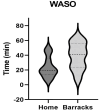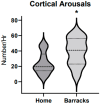Sleep Differences in Firefighters: Barracks vs. Home
- PMID: 39338038
- PMCID: PMC11431023
- DOI: 10.3390/ijerph21091155
Sleep Differences in Firefighters: Barracks vs. Home
Abstract
It has been shown that the firefighter occupation leads to poor sleep quality and sleep architecture. Disturbed sleep in these occupations can lead to deleterious outcomes including a series of chronic diseases and illnesses such as CVD.
Purpose: The aims were (1) to quantify firefighters' sleep via polysomnography, (2) to identify differences between sleeping in the barracks versus sleeping at home, and (3) to compare firefighter data to age-matched normative data. We expected significant differences between both the home and the barrack conditions as well as significant differences when both conditions were compared to normative data.
Methods: 10 male firefighters completed 3 nights of polysomnography recordings (SleepProfilerTM (Advanced Brain Monitoring, Carlsbad, CA, USA)) counterbalanced in both their own beds or barracks. A one-way rmANOVA statistical analysis was used to determine differences in sleep values with a Bonferroni correction if a significant difference was found with significance set at p < 0.05.
Results: Three important variables, cortical arousals (p < 0.05), autonomic activations (p < 0.01), and spindle duration (p < 0.01), had differences that were statistically significant between sleep at home or in the barracks, with sleep in the barracks being more disturbed. Clinical differences were also observed between the home and barrack conditions and all sleep results were more deleterious when compared to normative data.
Conclusions: The data demonstrates that firefighters show poor sleep quality and heavily impacted sleep architecture. This may be due to the effects of rotating shifts and occupational stress on the sleep-wake cycle. These results, when compared to age-matched normative data, show clinical manifestations of disturbed sleep in the firefighter population.
Keywords: firefighters; sleep architecture; sleep characteristics.
Conflict of interest statement
The authors declare no conflicts of interest.
Figures




References
MeSH terms
LinkOut - more resources
Full Text Sources

